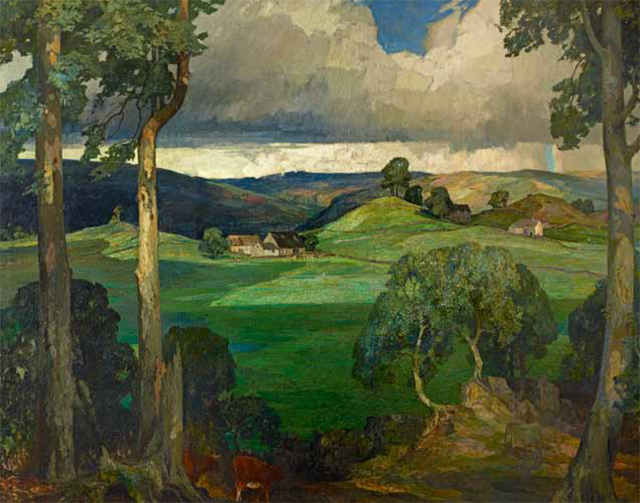My Favourite Painting: HRH The Prince of Wales
HRH The Prince of Wales chooses his favourite painting for Country Life.


Storiths in Wharfedale on The Bolton Abbey Estate, 1929, by Reginald ‘Rex’ Vicat Cole (1870–1940), 481/2in by 60in, the Dowager Duchess of Devonshire
The Prince of Wales says: 'When I first saw this painting hanging in the Dowager Duchess of Devonshire’s sitting room at Chatsworth, I was utterly transfixed by it. It elicited an instant, emotional response—it made me feel happy looking at it. It’s the subtle play of light and shade on a landscape I love, the deep darkness of the hill in the distance contrasting with the ray of sunlight catching the trunk of the tall tree in the foreground and the juxtaposition of the buildings in their perfect setting that makes it such a masterpiece of observation and painterly skill. Just by gazing at this painting you can literally feel yourself there, under the canopy of those trees rustling in the wind, with the clouds and shafts of sun scudding across that heavenly Wharfedale landscape. A sight for sore eyes and a reassuring reminder of precisely why the English landscape is a balm to the soul.'
John McEwen comments: 'There is nothing in landscape so difficult to paint well as tree forms against the sky, except the sky itself,’ wrote Rex Vicat Cole in his book The Artistic Anatomy of Trees, published in 1915. Vicat Cole was educated at Eton and, in 1900, was elected a member of the Royal Society of British Artists and married a Yorkshire farmer’s daughter. His marriage perhaps reflected his first enthusiasm for the landscape of Bolton Abbey, famed for its ruined medieval priory and the Duke of Devonshire’s northern sporting estate.
In 1910, Vicat Cole and his friend and fellow artist Byam Shaw opened the Byam Shaw and Vicat Cole School of Art in Kensington. He joined the Artists Rifles in the First World War and, on Shaw’s death in 1919, became principal of the school until his retirement in 1926. ‘Latterly, people have been reading strangely involved writings on art,’ wrote Cole in 1916, ‘and… this, and their visits to some new exhibitions of canvases daubed by people of weak intellect, have led them to believe that all representations of nature as we know and love her are wrong, and they are persuaded to profess admiration only for that which no one can understand.’
In 2003, the Byam Shaw was dissolved in Central Saint Martins College of Art and Design. Happily, the independent Prince’s Drawing School prevails (www. princesdrawingschool.org).'
This article was first published in Country Life, November 13, 2013
Sign up for the Country Life Newsletter
Exquisite houses, the beauty of Nature, and how to get the most from your life, straight to your inbox.
Country Life is unlike any other magazine: the only glossy weekly on the newsstand and the only magazine that has been guest-edited by HRH The King not once, but twice. It is a celebration of modern rural life and all its diverse joys and pleasures — that was first published in Queen Victoria's Diamond Jubilee year. Our eclectic mixture of witty and informative content — from the most up-to-date property news and commentary and a coveted glimpse inside some of the UK's best houses and gardens, to gardening, the arts and interior design, written by experts in their field — still cannot be found in print or online, anywhere else.
-
 Some of the finest landscapes in the North of England with a 12-bedroom home attached
Some of the finest landscapes in the North of England with a 12-bedroom home attachedUpper House in Derbyshire shows why the Kinder landscape was worth fighting for.
By James Fisher
-
 The Great Gatsby, pugs and the Mitford sisters: Country Life Quiz of the Day, April 16, 2025
The Great Gatsby, pugs and the Mitford sisters: Country Life Quiz of the Day, April 16, 2025Wednesday's quiz tests your knowledge on literature, National Parks and weird body parts.
By Rosie Paterson
-
 My favourite painting: Allan Mallinson
My favourite painting: Allan MallinsonMilitary historian Allan Mallinson picks an image of 'faith, generosity and ultimate sacrifice'.
By Charlotte Mullins
-
 My Favourite Painting: Piet Oudolf
My Favourite Painting: Piet Oudolf'One cannot sense whether he is far out on the ocean or closer to shore, or what he may be watching or feeling in that moment as he stares towards the beach.’
By Country Life
-
 My Favourite Painting: Mary Plazas
My Favourite Painting: Mary Plazas'There is compassion, awe, humility, a knowing yet a questioning in the glistening eyes. It moves me, it inspires me beyond the need to know.’
By Country Life
-
 My favourite painting: Robert Kime
My favourite painting: Robert KimeRobert Kime shares his fondness for New Year Snow by Ravilious
By Country Life
-
 My Favourite Painting: Anna Pavord
My Favourite Painting: Anna PavordAnna Pavord chooses a picture which reminds her of where she grew up
By Country Life
-
 My favourite painting: The Duchess of Wellington
My favourite painting: The Duchess of WellingtonThe Duchess of Wellington chooses her favourite painting for Country Life.
By Country Life
-
 My favourite painting: Maureen Lipman
My favourite painting: Maureen LipmanMaureen Lipman chooses her favourite painting for Country Life.
By Country Life
-
 My favourite painting: Jacqueline Wilson
My favourite painting: Jacqueline Wilson'I looked at this painting and decided to write about a Victorian circus girl one day'
By Country Life